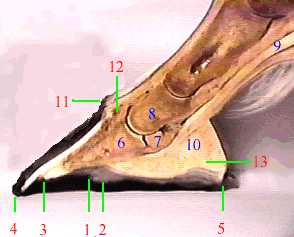|
1 - Apex of Frog
|
2 -Duckett's Dot
|
3 - Tip of coffin bone
|
|
4 - Tip of horn growth
|
5 - Buttress of frog
|
6 - Coffin bone
|
|
7 - Navicular bone
|
8 - Short pastern
|
9 - Deep digital flexor tendon
|

|

|
| 10 - Digital cushion (Includes ungual cartilage)
|
11 - Coronary band
|
|
12 - Extensor process
|
13 - Heel
|
For those readers scratching your heads over Duckett's Dot, it is located about 3/8" behind the apex of the frog and should be at the widest part of the foot.
Points of Contact
Ovnicek applied ink to flat pieces of wood and rubbed them across the soles of wild horse feet to determine where the feet were making contact with the ground. What he consistently found was a hoof structure which made ground contact at four distinctive points; both bars and at the corners of the toe. In some feet there were some "white zone" structures which formed up a rim of sorts inside the toe, arching between the anterior (front) points, which also made some incidental contact. These structures were where the toe should be in cases where toes were a little long and were being eliminated.
The hoof wall made No Contact with the ground and was not, in that context, a direct weight bearing structure. The sole and four points made contact and bore the weight, typically along the bars and in "the white zone" (laminae / sole junction).
Thus the sole and corners of the toe were heavily calloused and in direct contact with the ground. In addition, the anterior portion of the frog was also in direct contact with the ground. In 50% of the horses, the frog extended about 1/4" below the heels (made ground contact first).
Exfoliation of Excess Material
The hoof is undergoing a constant process of elimination. Flares occur and excess hoof wall is shed, usually along a ring. Since the wild horse does not bear weight on the hoof wall itself, this elimination does not have the negative connotations which we might attribute to it. It is a necessary component in hoof wall maintenance.
There is a pattern and logical mechanical progression to the breaking of the hoof wall which varies according to the terrain in which the horse lives. For example:
- On hard ground, such as the rocky terrain in the Pryor Mountains area, the hoof wears
reasonably level, maintaining a+/- 55 degree angle.
- On medium ground, such as sod covered clay, the side hoof walls would flare and break
away just forward of the bars leaving heel points which would underrun, or extend
downward behind the flare breaks, to as much as 6 degrees, forming natural "heel
caulks."
- On soft sand, these naturally underrun heels would extend up to 11 degrees below the
actual plane of the sole.
(Sketches will be drawn and scanned in.)
The soles and sensitive frog underwent constant natural exfoliation of excess material in the areas where contact was not important. With respect to the frog, the apex exfoliated first, then the median portion, however the anterior, or buttress of the frog did not exfoliate but rather was substantially calloused.
Preliminary Conclusions
While it was already generally understood that the horse's hoof was a dynamic structure, it appeared to be more responsive and self-correcting than many people thought.
On horses which traveled between 5 and 35 miles a day, the hoof structures showed consistently similar attributes over a wide number of horses examined.
The hoof wall did not contact the ground and was not a direct component in "earth-hoof" contact, but was rather more of a containment, protection and to a minor extent an energy dissipation structure.
The sole appeared to be the most responsive structure on the bottom of the horse's foot and adapted almost immediately (within a few days) to changes in the environment.
Mud seemed to play an important part in supporting the horse's foot. The lips of the frog appeared to be designed to trap mud and mud packed into the sole appeared to help dissipate the force when the hoof struck the ground.
Thrush appeared to not be a factor even though the horses' feet were constantly caked with mud. This was attributed to the healthier condition of the tissues of the frog due to increased contact and stimulation, which was explained in better detail later in the lecture.
Press "Back" to return to the page which brought you here
KBR Horse Health Information, © 1998 Lamm's Kickin' Back Ranch and Willis & Sharon Lamm. All rights reserved. Duplication of any of this material for commercial use is prohibited without express written permission. This prohibition is not intended to extend to personal non-commercial use, including sharing with others for safety and learning purposes, provided this copyright notice is attached.
Email us to submit comments or request reproduction permission.